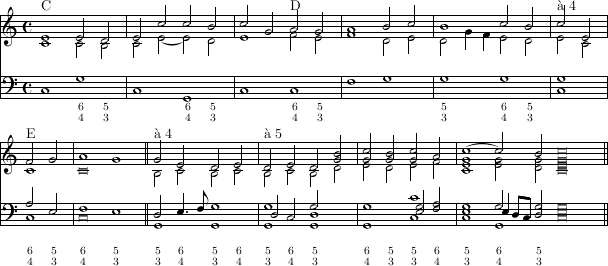
| Quarta dissonans supersÿncopata, die oben gebundene Quart, ist ein Grieff, so sich der Quart und zugleich der Quint wie auch der Octav bedienet. | Quarta dissonans supersyncopata, the fourth which is tied above, is a Grieff which uses the the fourth and the fifth at the same time as well as the octave. | La quarta dissonans supersyncopata, la quarte liée par le haut, est un Grieff qui utilise la quarte et la quinte en même temps, ainsi que l'octave. |
|
Sie wird gemeiniglich mit der Ziffer 4 einschichtig oder zweÿfach also
|
It is commonly assigned with the figure 4 singly or doubly as |
Normalement elle est indiquée par le seul chiffre 4 ou en double par
|
| Die Quart und Quint so die vornemb- und nothwendigste, die Octav die schlechtigste Consonanz. | The fourth and the fifth are the noblest and most neccessary, the octave the least consonance. | La quarte et la quinte sont les consonances les plus nobles et les plus nécessaires, l'octave est la moins importante. |
| Mit 3 Stimen sollen beede, [p.10] die Quint und Quart da seÿn, Exempel F. | With three voices, both fifth and fourth should be present, example F. | À trois voix, la quarte et la quinte doivent être présentes, exemple F. |
| Mit 4 sezt man zu der Quart und Quint die Octav, G, oder man duplirt die Quint, H. | With four one puts the octave together with the fourth and the fifth, or one doubles the fifth, H. | À quatre voix, on ajoute l'octave à la quarte et la quinte, ou on double la quinte, H. |
| Mit mehrern Stimen verdoppelt man nach Belieben die Quint und die Octav, die Quart aber nit, J. | With more voices one doubles at will the fifth and the octave, but not the fourth, J. | À plus de quatre voix on double à volonté la quinte et l'octave, mais pas la quarte, J. |
| Man accompagniere nun mit wenig oder viel, so soll allzeit die Quart im vorigen Grieff vorbereitet und gebunden, im nachkomenden aber abwerts gradatim absteigend resolviert werden, wie in vorigen Exempel zu sehen. | Whether one is accompanying with few or many voices, the fourth should always be prepared and tied in the previous Grieff, and should be resolved by gradually descending, as to be seen in the previous examples. | Que l'on accompagne à peu ou à beaucoup de voix, on doit toujours préparer et lier la quarte dans le Grieff précédent, et on doit la résoudre en descendant conjointement, comme on peut le voir dans les exemples précédents. |
| Man bedient sich fast [immer] dieses Grieffs zu den Cadenzen, wie hernach wird gesagt werden | One uses this Grieff almost [always] in the cadences, as will be told afterwards. | On utilise ce Grieff presque [toujours] dans les cadences, comme on le verra plus tard. |
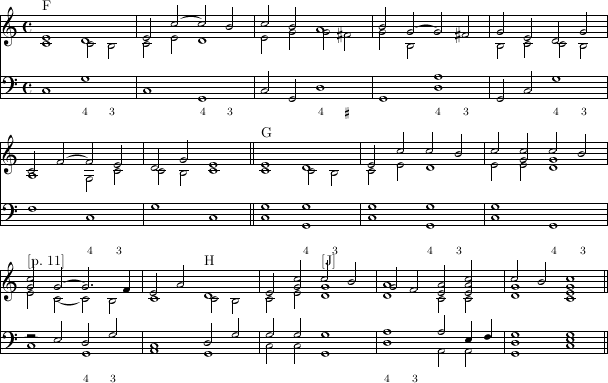
| Mit 4 Stimmen oder mehr soll man sich befleissen, daß mehrentheils die Quart oder Quint in der obersten Simme seÿ, die Octav selten. | With four or more voices one should try to play the fourth or the fifth in the upper most voice, seldom the octave. | À quatre voix ou plus, on doit la plupart du temps essayer de placer la quarte ou la quinte dans la voix supérieure, rarement l'octave. |
| Schlecht [*] | Bad [*] | Mauvais [*] |

| Etwas besser | Somewhat better | Un peu mieux |

| Quarta subsÿncopata, die von unten gebundene Quart, wird erkennet, wann der Baß durch ein gebundene Noten oder durch einen Punkten haltend die Quart annimbt und ausstehet, nach derselben aber gleich gradatim absteiget, also, daß der Baß die Quart bindet und resolviret, die Oberstimm aber die Quart ungebundener schlagt. | Quarta subsyncopata, the fourth which is tied below, one recognises when the bass makes the fourth during a tied note or during a note with a point and sustains it and descends gradually after it, such that the bass ties and resolves the fourth while the upper voice plays the fourth untied. | La quarta subsyncopata, la quarte qui est liée par le bas, se reconnait quand la basse fait entendre et tient la quarte pendant une note liée ou pointée et qu'elle descend conjoitement après celle-ci, de manière à ce que la basse lie et resolve la quinte; par contre, la voix supérieure joue la quarte sans la lier. |
| In diesen Grieff gesellet sich zu der Quart die Secund am besten, dahero mit 3 Stimm diese zweÿ Consonantien unausbleiblich genommen werden müssen, K. | In this Grieff, the fourth is best joined by the second, thus with three voices one has strictly to play these two notes, K. | Dans ce Grieff, la quarte est jointe au mieux par la seconde; par conséquence, à troix voix, on doit obligatoirement faire entendre ces deux consonances, K. |
| Mit [p.12] 4 aber kann die Quint oder die Sext darzu genommen werden, L. | But with four, the fifth or the sixth can be added, L. | Mais à quatre voix, on peut rajouter la quinte ou la sixte, L. |
| Mit 4 und mehrer Stimm kann die Secund am fieglichsten, M, bisweilen auch die Quart, N, ja wohl auch die Quint oder die Sext verdoppelt werden, O. | With four and more voices one doubles best the second, M, sometimes also the fourth, N, even also the fifth or the seventh, O. | À quatre voix ou plus, on peut doubler au mieux la seconde, M, parfois aussi la quarte, N, et même la quinte et la septième, O. |
|
Ob nun zu der Quart und Secund die Quint lieber als die Sext soll erwehlet
werden, muß das Gehör am meisten judicren, doch wo nur die Quart, also 4 oder
mit der Secund |
Whether one should choose better the fifth or the sixth together with the
fourth, should be decided by the ear, but where only the fourth, i.e. 4 or
with the second |
Il faut décider à l'oreille s'il est préférable de choisir la quinte ou la
sixte avec la quarte et la seconde; mais quand seuléement la quarte est
indiquée, c'est-à-dire 4, ou avec la seconde |
| Doch spillet man am sichersten, wann man weder Quint noch Sext nimbt, sondern die Secund und Quart duplirt, Q. | But one plays safest when one does not take neither the fifth nor the sixth, but doubles the second and the fourth, Q. | Pourtant, on joue avec plus de sécurité quand on ne prend ni la quinte ni la sixte, par contre, on double la seconde et la quarte, Q. |
| Es kann auch ein Terz mit der Quart genommen werden, soll aber gezeichnet, oben gebunden, und in nachkommenden Grieff, da der Baß absteigen wird, ebenfalls absteigend gradatim salvirt werden, R. | Also the third can be taken with the fourth, but it should be assigned and be tied above, and in the following Grieff, where the bass will descend, it should also be resolved by gradually descending. | La tierce peut aussi être jouée avec la quarte, mais elle doit être indiquée et liée par le haut; dans le Grieff suivant où la basse descend, elle doit être résolue pareillement en descendant par mouvement conjoint. |
| Mit der Terz aber nimbt man keine Secund. | But with the third one does not take the second. | Mais avec la tierce on ne joue pas la seconde. |
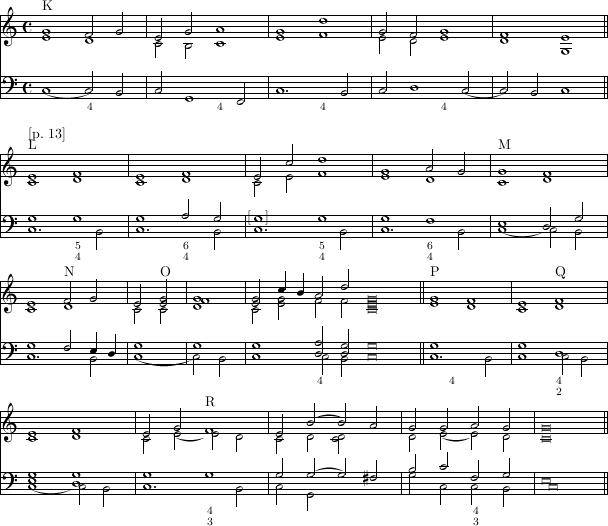
|
| Quarta transiens, the passing fourth, which creeps through upon a standing note in the bass, such that the bass steadily remains at the same note before and after the fourth. | La quarta transiens, la quarte passante, qui glisse en passant sur une note continue de la basse, de manière à ce que la basse reste toujours au même endroit avant et après la quarte. |
| Zu und von der Quart soll niemahl gesprungen werden, sondern gradatim auf- und abgestiegen werden, S. | To and from the fourth one should never jump, but ascend or descend gradually, S. | On ne doit jamais sauter de ou sur la quarte, mais monter et descendre de manière conjointe, S. |
|
Mit 3 Stimmen kann mit solcher Quart ein Sext genommen werden und alldar ist es
viel mehr Quarta consonans oder die sieße Quart zu nehmen, von welcher wir
schon geredet haben; sollte aber die Quart billich allzeit also gezeichnet seÿn
|
With three voices on can play the sixth with such a fourth, and there it is
much more to be considered as a quarta consonans or sweet fourth,
about which we have already talked; but this fourth should always be figured as
|
À trois voix, on peut jouer cette quarte avec une sixte;
il s'agit alors plutôt d'une quarta consonans ou quarte douce, dont
nous avons déjà parlé; mais elle doit toujours être indiquée avec
|
| Da aber die Quart allein also 4 ohne Sechser gesezt wird, pflegt man gemeiniglich die Secund darmit zu nehmen, welche zwar so wohl als die Quart vor und nach gradatim gehet, V, oder es wird bisweilen auch sehr zierlich mit der Quart die Septima major genommen, zu und von welcher ebenfalls nur gradatim zu schreiten erlaubt ist, X. | But when the fourt is put alone, i.e. 4 without a six, one usually plays the second with it, which goes gradually before and after as the fourth, V, or sometimes and very adorning, one takes the major seventh together with the fourth, to and from which also only proceeding gradually is allowed, X. | Cependant, quand seule la quarte est indiquée, c'est-a-dire 4 sans six, on lui ajoute normalement la seconde, celle-ci devant procéder par mouvement conjoint préparée et résolue comme la quarte, V, ou alors,on fait entendre parfois très gracieusement la septième majeure avec la quarte, vers et à partir de laquelle il est seulement permis de procéder par mouvement conjoint, X. |
| Mit 4 und mehr Stimmen, wann die Sext zu der Quart gezeichnet ist, soll man observiren, was schon vorhin von der sießen Quart gesagt worden. | With four and more voices, if the sixth is assiged with the fourth, on should observe what has been told before about the sweet fourth. | À quatre voix ou plus, quand la sixte est indiquée avec la quarte, on doit suivre ce qui a été dit ci-dessus au sujet de la quarte douce. |
| Ist aber die Sext darbeÿ nicht angedeutet, so wird mit der Quart die Secund und die Sept mit obgemelter Behutsambkeit vor und nach einer jeden dieser 3 Consonantien nur gradatim zu gehen zierlich genommen, Y, aus welcher die Quart und Secund nach Gefallen können dupliert, die Sept major aber nur einfach jederzeit genornen werden, Z. [P.15] | But if the sixth is not assigned with, one plays the seventh and the second together with the fourth, where one takes care, as above stated, to proceed into and from these three consonances only gradually, Y, where the fourth and the second can be doubled at will, but the seventh has always to be taken singly, Z. | Mais quand la sixte n'est pas indiquée avec la quarte, on joue la septième et la seconde avec la quarte, en prenant garde, comme dit ci-dessus, d'avancer uniquement conjointement vers et à partir de ces trois consonances , Y; la quarte et la seconde peuvent être doublés à volonté, mais la septième doit toujours rester seule, Z. |
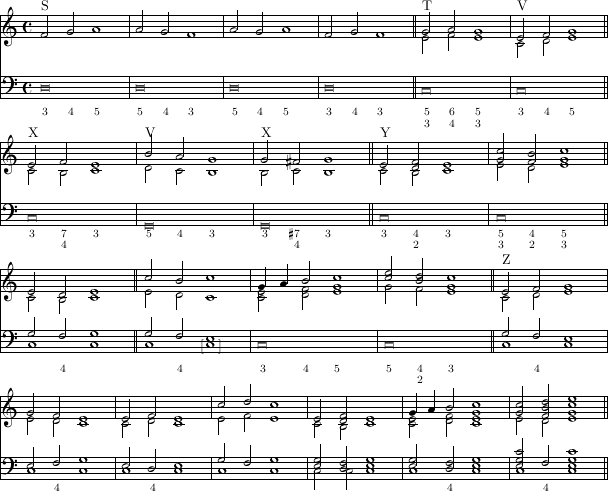
|
| Quarta Italica, the "welsh" or irregular fourth, which appears a bit more seldomly, is a Grieff in which one of the upper voices holds the fourth before and after while the bass is moving, and with the fourth the third is taken stepwise upwards before and afterwards, example A. | La quarta Italica, quarte welche ou irregulière, plus rare, est un Grieff dans lequelle la quarte est tenue avant et après par une voix supérieure pendant que la basse bouge; avec cette quarte on joue la tierce qui monte conjointement avant et après cet accord, exemple A. |
| Mit 4 Stimmen wird mit der Quart neben der Terz die Sext am fieglichsten genornen, Exempl B. | With four voices one takes best the sixth next the third together with the fourth, example B. | À quatre voix, la meilleure solution est d'ajouter à la quarte la sixte à coté de la tierce, exemple B. |
Mit mehr Stimmen lassen sich so wohl die Terz als Quart dupliren, wann man nur
Achtung gibt, daß die Quart stehet halten [= liegen bleibt]; die Sext aber
absonderlich, wann sie major oder mit einen Diesi  ist, bleibt
gemeiniglich nur einfach, Exempl C. ist, bleibt
gemeiniglich nur einfach, Exempl C.
|
With more voices one can double the third as well as the fourth, provided one
pays attention that the fourth is hold; but the sixth, especially when it is a
major one or has a sharp  , is commonly left singly, example C. , is commonly left singly, example C.
| À plus de quatre voix, on peut doubler la tierce aussi bien que la quarte, en prenant garde à ce que la quarte soit tenue; mais la sixte, en particulier quand elle est majeure ou diésée, reste normalement seule, example C. |
| Die Octav kann auch mit gehen. | The octave can also be taken with. | On peut aussi ajouter l'octave. |
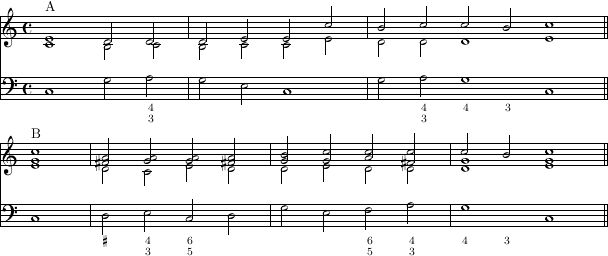
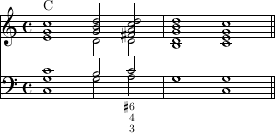
|
| Tritonus or quarta major, false or major fourth, is a Grieff in which one takes the false major fourth, to which one plays commonly the sixth or the second in three voices, Example D. | Le tritonus ou quarta major, fausse quarte ou quarte majeure, est un Grieff dans lequel on joue la fausse quarte majeure; à trois voix, on fait entendre la plupart du temps la sixte ou la seconde, exemple D. |
| Dieser Grieff geschieht unterschiedlicher Weis, denn bisweilen gibt es sich selbst, daß mit der obern Stimm man nur liegen bleibt, da hingegen der Baß zu der falschen Quart sich beweget, E. | This Grieff occurs in different ways, since sometimes it happens that one stays with the upper voice while the bass moves into the false fourth, E. | Ce Grieff apparaît sous différentes manières, car il arrive parfois que la voix supérieure ne bouge pas alors que la basse procède vers la fausse quarte, E. |
| Bisweilen und öffter aber, da der Baß fest haltet, muß man mit denen Oberstimmen die falsche Quart mit ihren Accompagnamento oder Begleitung nur köckh [=keck] schlagen, F. | More often however, when the bass stays, one has boldly to hit the false quarte and its accompaniment with the upper voices, F. | Cependant et plus souvent, quand la basse ne bouge pas, on doit hardiment frapper la fausse quarte et son accompagnement avec les voix supérieures, F. |
| Leztlich geschieht auch, daß so wohl der Baß als die Oberstimm gegeneinander sich bewegend diesen Grieff so wohl gradatim, G, als auch durch einen Sprung köckh zu nehmen sich nit zu scheihen haben, so aus denen Zieffern abzunehmen ist, da nemblich erhellet, daß solcher Grieff nicht kann vorbereitet oder gebunden werden, H. | Finally it happens that the bass as well as the upper voices move together and form this Grieff either gradually or even and without hesitating boldly by a jump, as one can see from the figures which show that this Grieff cannot be prepared or tied, H. | Finalement, il arrive que et la basse et les voix supérieures puissent former ce Grieff en bougeant mutuellement, soit conjointement soit hardiment sans hésiter par un saut, quand la lecture des chiffres montre qu'on ne peut pas préparer ou lier ce Grieff, H. |
| Die Oberstimm, so den Tritonum oder falsche Quart gehabt hat, soll jederzeit in nachkommenden Grieff gradatim hinauff steigen, wie in allen Exempeln zu sehen. | The upper voice which had the tritonum or false fourth, should always gradually ascend in the following Grieff, as to be seen in all examples. | La voix supérieure, quand elle a eu le tritonum ou la fausse quarte, doit toujours monter conjointement vers le Grieff suivant, comme on peut le voir dans tous les exemples. |
| Die Stimme aber, so die Secund gehabt hat, pflegt nach der Secund in folgenden Grieff entweder stets zu verharren, J, oder quartweis aufwerts, K, oder quintweis abwerts zu springen, L. | The voice, on the other hand, which had the second, commonly either stays in the subsequent Grieff, J, or jumps up by a fourth, K, or down by a fifth, L. | Mais normalement, la voix qui a eu la seconde, reste fixe dans le Grieff suivant, J, ou alors, elle saute d'une quarte vers le haut, K, ou d'une quinte vers le bas, L. |
| Es kann auch zu der falschen Quart ein Terz mit einstimmen, welche aber gezeichnet soll seyn: und als dann hat die Secund keine statt darbeÿ, soll auch entweder gemelte Terz vorgebunden, M, oder, da dieses nit geschehen kunnte, aufs wenigst gradatim absteigend resolviert werden, M, N. | The false fourth can also be joined by a third, but this should be assigned: and then the second must not be played with it, and this third should either be tied before, M, or, when that is not possible, should at least be resolved by descending gradually, M, N. | On peut aussi faire entendre une tierce avec la fausse quarte, mais elle doit être indiquée: dans ce cas, on ne peut pas ajouter de seconde, et cette tierce doit être soit préparée, M, soit, si ce n'est pas possible, résolue en descendant conjointement, M, N. |
| Da nach der falschen Quart der Baß einen Quartsprung hinunter, 0, oder ein Quintsprung hinauff thut, P, hat auch die Secund kein statt hier, sondern nur die Sext, 0, P. | After the false fourth, when the bass jumps a fourth upwards, O, or a fifth downwards, P, the second must not be used here also, but only the sixth, O, P. | Quand la basse saute après la fausse quarte d'une quarte vers le haut, O, ou d'une quinte vers le bas, la seconde n'est pas permise, seule la sixte est tolérée, O, P. |
| Mit 4 Stimmen, da die falsche Quart mit der Secund oder mit der auf obangezogene Weis gezeichnete Terz genommen [p. 18] werden, sezt man noch hinzu die Sext, Q, oder es wird die Secund duplirt, R. | With four voices, when the false fourth is taken with the second or in the above given way with the third, one adds the sixth, Q, or the second is doubled, R. | À quatre voix, quand la fausse quarte est jouée avec la seconde ou, dans la manière expliquée ci-dessus, avec la tierce, on ajoute encore la sixte, Q, ou on double la seconde, R. |
| Mit völligern Grieffen pflegt man die Secund und die Sext nach Belieben, die falsche Quart aber, S, wie auch die gemelte Terz, T, niemahls zu dupliren. | With fuller Grieffen, one usually doubles the second and the sixth at will, but the false fourth, S, as well as the mentioned third, T, is never doubled. | Pour les Grieffen plus pleins, on double la seconde et la sixte selon son envie; par contre, on ne double jamais la fausse quarte, S, ainsi que la tierce mentionnée, T . |
| Da nach der falschen Quart der Baß springt, laßt man die Secund aus und haltet man nur anstatt ihrer die Octav, V, welche in völligern Grieffen kann auch allerseits haltend dupliert werden, X. | When the bass jumps after the false fourth, one omits the second and holds the octave instead, V, which, being hold, can be doubled as well, X. | Quand la basse saute après la fausse quarte on omet la seconde et on garde l'octave sur la même note, V, laquelle, étant tenue, peut être doublée aussi, X. |
| Leztlich ist auch zu wissen, daß [die falsche Quart] bisweilen wie die Quart consonans oder sieße Quart, Y, bisweilen wie die Quart dissonans abgebunden, Z, bisweilen auch wie ein quarta transiens oder durch passirende Quart, AA, und entlich auch wie ein wellische Quart, BB, gebraucht wird, welches aus denen Zieffern zu urtheilen ist; | Finally, one should note that [the false fourth] is sometimes used as a quarta consonans or sweet fourth, Y, sometimes as a quarta dissonans tied, Z, and sometimes as well as a quarta transiens or passing fourth, AA, and finally as a "welsh" fourth, BB, which is to be judged from the figures; | Finalement, il faut savoir que [la fausse quarte] est utilisée parfois comme la quarta consonans ou quarte douce, Y, parfois comme la quarta dissonans liée, Z, ou encore comme la quarta transiens ou quarte passante, AA, et finalement comme la quarte welsche, BB, que l'on juge selon les chiffres. |
| als dann aber observirt man das Accompagnato oder die Regl, so von einer jeden dieser absonderlich schon gegeben worden, doch nur dieses noch darbeÿ zu observiren, daß obschon in ienen vor guten Quarten gegebene Instruction bisweilen die Quart zu dupliren erlaubt ist, dannoch wann anstat der guten die falsche Quart oder Tritonus gesezt wird, solche leztlich harte Dissonans niemahlen duplirt wird. | In that case one observes the accompaniment or rule which has already been given for each of them, but observing still that though in the instructions about the good fourth it was sometimes allowed to double the fourth, once the false fourth or the tritonus is written instead of the good, this hard dissonance should never be doubled. | Dans ce cas-là, on suit l'accompagnement ou la règle déjà donnée pour chaque sorte, mais quand la fausse quarte ou le tritonus est posé à la place de la bonne (quarte), on doit encore être attentif au fait que cette dissonance dure ne soit jamais doublée, bien que selon les instructions sur la bonne quarte, il est permis de doubler la quarte. |

| Unterschied aller obbesagten Grieff, so aus der Quart entstehen, und solche aus der Partitur leidlich zu erkennen. | Difference between all above mentioned Grieff which originate from the fourth and which are fairly to recognise from the score. | Différences entre les Grieff sus-mentionnés découlant de la quarte et qui sont assez reconnaissables dans la partition. |

last modified Wed Mar 14 15:02:19 2007 by Bernhard Lang previous: concentus-semisextilis
up: muffat-regulae
next: secund